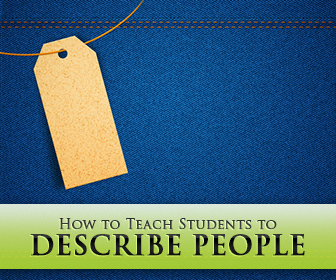Ask a student to describe someone in their family.
Answers vary from the basic use of adjectives (tall, short, intelligent) to a complete loss for words. Rarely do they give good, solid descriptions, the kind that really allows you to picture what the person’s like.
Describing people is not as simple as it sounds. So here are some tips you might find useful when teaching students to do it.

9 Steps to Successful Description
-
1
Set the Context
Instead of randomly teaching students how to describe people, try to fit it into a context.When is it necessary to describe oneself or someone else? Let’s face it. It’s not something that comes up in everyday conversation; there are a limited number of situations in which we are required to describe people:
- When we are getting to know someone, we may mention and describe someone in our family
- When someone has to meet someone they’ve never met before face to face (they’re picking them up at the airport)
- When we’re trying to get someone to meet someone else (to go on a date, for example).
So instead of randomly teaching students how to describe people, try to fit it into a context. Good opportunities are when talking about family, talking about airport situations or even business meetings (arranging to meet someone at a restaurant for a business lunch).
-
2
Introduce What’s he/she like?
Say your class is talking about their families. Introduce common adjectives to describe character and personality if they’re not already familiar with them. Then, go back to their families: Juan, you have a brother. What’s he like? Prompt students to use any of the adjectives they’ve just learned. Students take turns describing family members – only in terms of character or personality. Students take turns asking each other: What’s your mother like? What’s your sister like? What’s your boyfriend like?
-
3
Introduce What does he/she look like?
Introduce adjectives used for physical description. Make sure students understand that in some cases they must use adjectives with the verb to be (he is tall; she is slim), but that in other cases they must use the verb to have (he has brown hair; she has blue eyes). Go back to their families: Juan, you have a brother. What does he look like? Students take turns describing family members – only physical descriptions right now. Students take turns asking each other: What does your brother/mother/sister look like?
-
4
Contrast the Difference Between the Two
Make sure students understand the difference between asking what’s he like and what does he look like. Have students take turns asking each other and answering both questions. Have them ask about family members, best friends, bosses, etc…Stress the fact that the word like is not used in the answer in either case. If necessary, show what happens when we ask questions with the verb like (Does he like chocolate?)
-
5
To Be vs. To Have
Make sure understand in which cases they must use the verb to be (when using adjectives like tall, sensitive, polite, etc…) and in which cases they must use the verb to have (blond hair, brown eyes). Split the board into two columns and have each student contribute an example for each.
-
6
Modifying Descriptions
The next logical step is to teach them how to adjust and modify descriptions so that they are more accurate. For height, for example, saying that someone is either tall or short may not be very accurate, so teach them to say he/she is medium height/not too short/a little short/quite tall/rather tall, etc…
-
7
Comparisons
You probably won’t get to it in the same lesson, but at some point you will teach them comparatives and superlatives. This is a great opportunity to review descriptions and make some interesting comparisons with both short and long adjectives: My brother is quieter, and I’m more talkative.
-
8
Being Polite
When teaching students how to describe people, it is also recommended that you teach them how to do so in polite terms. Teach them different options for the word fat, for example, words like stout, big boned or overweight. The same thing goes for adjectives like stupid or dumb. When referring to race or ethnicity, teach them the socially-accepted terms: Asian American, Latin American, African American, etc…
-
9
Describe! Describe! Describe!
Give your class lots of practice describing people. One of the best ways to do this is to use celebrity photos. Here are some ideas for fun activities:
- The Dating Game: in pairs, Student A chooses three candidates from the pile of celebrity photos and describes each to Student B. Student B has to pick the one he/she would like to date.
- Who am I?: in pairs, Student A chooses a secret celebrity identity and describes himself/herself. Student B has to guess who he/she is.
It may not be the most essential thing they’ll learn in class, but it is definitely necessary.
With the right words and expressions, there will be no confusion as to who will be picking them up at the airport!
P.S. If you enjoyed this article, please help spread it by clicking one of those sharing buttons below. And if you are interested in more, you should follow our Facebook page where we share more about creative, non-boring ways to teach English.







